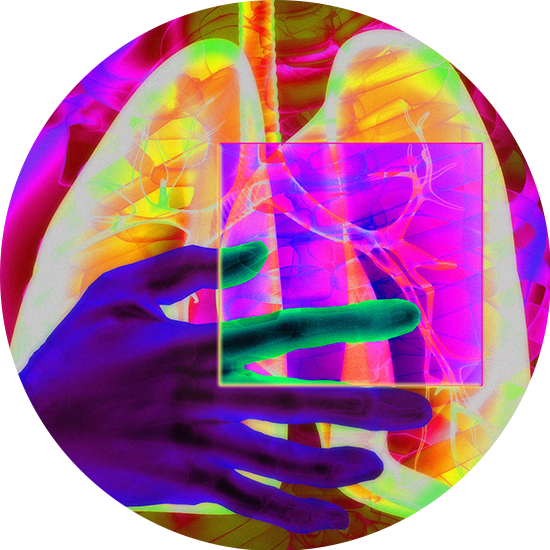
Chapter 8: Oxygen Manifesto
Advice from 5 Respiratory Specialists
Written by Noah Greenspan, PT, DPT, CCS, EMT-B; Mark W. Mangus Sr., RRT, RPFT, FAARC; Ryan Diesem, RRT, RRT-NPS; Donna Frownfelter, PT, DPT, MA, CCS, RRT, FCCP; and Marion Mackles, PT, BS, LMT
Oxygen Manifesto 1: Originally printed in Pulmonary Hypertension News, March 27, 2019
One of the more hotly debated topics in the treatment of respiratory disease is supplemental oxygen use. Participants in the debate often include patients, clinicians, caretakers, suppliers, advocacy groups, and even politicians. In my experience, the information regarding when and how to use supplemental oxygen ranges in quality from the good, the bad, and in keeping with our western theme, the complete bull. It is my hope that I can help clear the air. That’s my third and final western pun. Thank you very much. I’ll be here all week.
Incidentally, I have previously given a webinar on this topic that you can watch HERE: https://vimeo.com/327196321
For this chapter, I have asked four respiratory and cardiopulmonary physical therapists, from whom I have learned a tremendous amount about proper oxygen supplementation, to join me in this endeavor: a man I call Respiratory Therapist-Laureate, Mark Mangus, Oxygen Super-Guru and author of the Pulmonary Paper’s Portable Oxygen Concentrator (POC) Guide, Ryan Diesem, the Godmother of Chest Physical Therapy, Donna Frownfelter, and my 28-year colleague and Mucus Buster, Marion Mackles.
“What, Me Oxygen?” -Alfred E. Neuman
At the most basic level, your body’s ability to use oxygen is based upon three main factors:
- how well your lungs move air, and consequently oxygen in and carbon dioxide out
- how well your heart pumps said oxygen-rich blood
- how efficiently your muscles utilize that oxygen
How well your body takes up and utilizes oxygen is based upon supply and demand. The good news is that all three of these factors can improve with exercise and activity and all three typically get worse with inactivity. As I say repeatedly, exercise is like pushing a car uphill. As soon as you stop pushing, you start rolling back downhill, only much more quickly. I am sure that most of us have experienced this at one time or another, so as Nike says, “Just do it!”
Why oxygen?
For people living with pulmonary fibrosis and other ILD’s it is not uncommon for one or more of these above-named factors to be impaired, causing hypoxemia and hypoxia, low oxygenation in the blood and tissues.
Oxygen Assessment
How much oxygen a person has in their blood can be determined by one of two tests, either by arterial blood gas (ABG) or via pulse oximetry.
Normal partial pressure of oxygen, as measured via ABG, ranges from about 75-100 millimeters of mercury (mmHg). Values of 60 or less indicate the need for supplemental oxygen.
Oxygen saturation, measured by either ABG or pulse oximetry, is considered normal when it is 95 percent or above. Values of 90 or less indicate the need for supplemental oxygen, although many insurance companies (including Medicare) require a saturation of 88 percent or less to cover supplemental oxygen.
Often, a patient will undergo a six-minute walk test to determine whether they desaturate with activity to qualify them for supplemental oxygen. However, wide variation in testing protocols from facility to facility and clinician to clinician, among other limitations, can lead to imperfect patterns of oxygen prescription and usage.
Shortness of breath does not equal saturation (SaO2%)
As I say over and over (and over) again, breathing is multifactorial, meaning there are many, many factors besides just the respiratory system and pulmonary function that can affect how well or how poorly we breathe. These include things such as cardiovascular health, level of conditioning (or deconditioning), medications, emotional state, and weather, among others.
Shortness of breath does not always indicate that you are hypoxic. In other words, your level of dyspnea, or air hunger, does not always correlate with your oxygen saturation.
This means that you can be short of breath, even extremely short of breath, even in the presence of normal oxygen saturation. Conversely, you can be hypoxic even if you are not particularly short of breath or disproportionately to your shortness of breath. Let’s examine what this means to you.
Why am I so short of breath if my oxygen saturation is OK?
One of the most common questions that I am asked is how a person can be so short of breath and yet have a normal oxygen saturation (see above: “Breathing is multi-factorial”). In the case of the individual who is short of breath but has a normal oxygen saturation, supplemental oxygenation will not help you. I repeat, if your oxygen saturation is normal, supplemental oxygen will provide little, if any benefit, other than what EMTs and paramedics often refer to as “psychological first aid” or what some medical professionals refer to as “Obecalp” (read it backwards). So, what should you do instead?
In my book, Ultimate Pulmonary Wellness, I describe in detail a technique that we call “Recovery from Shortness of Breath.” In a nutshell:
- Stop what you are doing. Nobody ever becomes less short of breath by continuing the activity that made them short of breath in the first place. You either must reduce your demand for air or increase your supply. The best way to reduce the demand is to stop whatever it is you’re doing.
- Talk to yourself, reminding yourself that you know what to do. Self-talk can be very empowering in high-stakes situations like these (if you do know what to do). If you don’t know, I would strongly recommend enrolling in either an in-person or online pulmonary rehabilitation program.
- Assume the position. There are certain positions we call “recovery positions” that will help you to regain control of your breathing. These include several variations of bending over or leaning forward, resting your arms on your thighs or on a stationary object or wall. This allows the abdominal contents to drop forward, improving respiratory mechanics.
- Begin controlled breathing techniques (CBT). These include controlled breathing techniques such as diaphragmatic and pursed-lip breathing, among others. Again, if you are not familiar with these techniques, I would strongly recommend enrolling in a pulmonary rehabilitation program, either in person or online.
- Reassess and adapt. Now that you’ve caught your breath, reassess the situation and continue the activity (if you can) using the controlled breathing techniques and modifying the activity.
- In addition to the above, if you have not already done so, now might be a good time to consider using your rescue inhaler (with your doctor’s blessing) to further increase your air supply. In an ideal world (and with your doctor’s blessing), you might consider pre-medicating approximately 15 minutes before activity.
How can my oxygen be so low if I am not even short of breath?
In the case of the individual who is not particularly short of breath but who is hypoxic as measured either by ABG or pulse oximetry, they need oxygen. Again, if your ABG or pulse oximeter indicate you are hypoxic, you need oxygen whether you are short of breath or not. Hypoxia, even in the absence of significant shortness of breath, increases your risk of coronary insufficiency/ischemia, arrhythmia, pulmonary hypertension, and heart failure, among other potential hazards to your health, so as Lung Man says: “Use your oxygen, dammit!”
Rely on your instruments!
Although many people are convinced that they can tell their own oxygen saturation based on how they feel, particularly as it relates to shortness of breath, I liken this to the “Guesser” who purports to guess your age, weight, or birth month at the carnival. Keep in mind that in the case of oxygenation, the stakes are much higher than a stuffed animal. And in the same way a SCUBA diver must rely on their depth gauge, or a pilot relies on an altimeter, I always advise people to rely on their instruments, not the way they feel.
When (and how often) should I measure my oxygen?
The goal of measuring your oxygen is not to turn you into an obsessive measurement freak. The goal is to make sure you are sufficiently oxygenated both at rest and at all levels of activity. This means that at least until you start to understand how your body responds to increasing activity and how much oxygen it takes to keep you saturated, you will have to take more frequent measurements. You might even consider keeping a journal for a while until you can fully assess your body’s needs. As you start to understand your body’s trends, you can measure less frequently or if you are in distress.
This goes for pulmonary rehabilitation programs as well. I hear from people all the time about rehab programs that measure your oxygen before and after exercise but crickets during exercise. Again, if we want to assess a plane’s performance in the air, we must take our measurements in the air, not just before takeoff and after landing.
Myths and misconceptions
Let’s also take a few moments to address some of the other myths, misconceptions, misinformation, and miseducation, as well as that famous river in northeast Africa (De Nile).
For the patient that only uses oxygen at home but not when they are out: Many people use their oxygen at home but do not take it with them when they leave the house. This is completely counterintuitive. Again, keeping in mind the principle of supply and demand, the times you need it most is when you are active and most likely to desaturate and contrary to what some people believe, you cannot somehow store oxygen in your body for use later. If — and this is a big IF — you want to “experiment” by not using your oxygen (with your doctor’s blessing), the time to do it is when you are at home where the environment is controlled and while you are at rest and the demand is low.
For the patient who “only goes down to 88 percent:” When it comes to oxygen saturation, each percentage point is not created equal. Due to the way our hemoglobin takes on and gives up oxygen (as evidenced by the S-shaped oxygen-hemoglobin dissociation curve), as you drop below 90 percent, the magnitude of oxygen change in your bloodstream is greater than when you are between 90 and 100. Think about it like this: You want to take a photo with the Grand Canyon behind you. You are 10 feet from the edge of the canyon. You can go anywhere between 1 and 10 feet with no ill effects, BUT, if you go that 11th foot — you get the idea. It is a similar principle with oxygen saturation. In addition, if we consider the plus or minus 3 percent (or more) error range of most pulse oximeters, a reading of 90 percent can be as low as 87 percent (or less).
For the patient whose oxygen “only goes down for a few minutes” or “recovers quickly:” I told you before that hypoxia increases the risk of many problems including coronary insufficiency/ischemia, arrhythmia, pulmonary hypertension, and heart failure. The risk increases the lower you go, the longer you stay there, and the more frequently you desaturate. But think of it like this. Imagine sitting in a glass booth that suddenly fills up with smoke, but don’t worry — it clears very quickly. I think most of us would agree it would be better if it never filled up with smoke in the first place. Well, that is how your brain, heart, and other vital organs feel about hypoxia, so as Lung Man says: “Wear your oxygen, dammit!”
Finally, for the patient who is worried about getting “too much oxygen:” It is for all these previously mentioned reasons that I like my patients to stay at 93 percent or greater during activity. This includes patients with COPD, PF, and PH including people who are “CO2 retainers.” Every time I say this, people bring up the concept of hypoxic drive and the concern that the patient will stop breathing if we give them too much oxygen.
Basically, the idea behind this theory is that when patients have chronically high levels of carbon dioxide and/or prolonged periods of pH imbalance, they switch over to “hypoxic drive.” In other words, instead of responding to high levels of CO2 or changes in acid-base chemistry, which are the normal stimuli for respiration, they now respond to low oxygen and if we give them “too much oxygen,” they will stop breathing all together.
Now again, this is a call that needs to be made by your physician, BUT I can say that in my more than 27 years as both a cardiopulmonary physical therapist and emergency medical technician in many, many different environments, I have never, ever, seen this happen. Neither has Mark. Neither has Ryan. Again, this is our experience, but you would think that in a few hundred thousand exercise sessions, one of us would have seen it at least once, especially considering the abundance of supplemental oxygen we use.
In the next section, we will discuss the various devices, accessories and best practices used in the delivery and usage of supplemental oxygen.
Oxygen Manifesto 2: Originally printed in COPD News Today, June 19, 2019
When it comes to home improvement, people typically want three things from a contractor: good, fast, and cheap. Under all but the most rigorous (and lucky) circumstances, you can choose any two of the three. What this means is that you can have it good and fast, but chances are, it’s gonna cost you an arm and a leg. And while you may be able to get it fast and cheap, I can assure you that it probably won’t be that good. Or you may also be able to get it good and cheap, but it’s not gonna be fast. This could be why we can never get in touch with our contractor (once they have your deposit, of course).
There is a similar scenario occurring in the world of supplemental oxygen. People want three things. They want a delivery system that will be small and lightweight. They want a system that will last a long time. And they want a system that will provide a high liter flow, AKA a lot of oxygen.
Well, guess what? You can choose any two. What this means is you can have a system that is lightweight and long- (or more likely, medium-) lasting, but it’s not going to give you much oxygen. You can have a system that is lightweight and delivers a lot (or at least a moderate amount) of oxygen, but it’s not going to last very long. Or you can have a system that gives you a fair amount of oxygen and lasts for a fair amount of time, but it won’t be light.
I tell you these things (as I have for more than three decades) not to scare you nor for the sole purpose of putting the oxygen companies on blast (although many of them need to be on blast). I tell you these things because I think it’s important for you to understand that the medical oxygen system is rigged, and not in your favor. And the systems themselves can be very confusing, even for many clinicians.
It also involves money, and as you know, often when a situation involves money, that’s when a lot of wolves; whose primary objective is to line their own pockets; come out in sheep’s clothing. Well, think of me as Little Red Riding Hood here to help you see the wolf for who he or she really is and help you get the best oxygen delivery system for you.
It’s sort of like the Seinfeld episode where Kramer comes up with a coffee table book about coffee tables. Well, it’s sad to say, but we need a better supplemental oxygen system for supplemental oxygen systems.
Recently, I received a phone call from a longtime patient named Mrs. M., inquiring about a new portable oxygen concentrator (POC) she was planning to buy with her own money. She was told by one of the company’s sales agents that the device could provide up to 6 liters per minute (lpm) of oxygen. I assured Mrs. M. that this could not possibly be true because no POC exists that can deliver 6 lpm. She was sure this was what the representative told her, so I asked her to have them call me.
I soon received a phone call from that person’s sales manager, who finally and reluctantly conceded that the numbers were manufacturer’s settings, not liters per minute. I wondered to myself if this was in fact a light bulb moment for him.
We eventually agreed that on a setting of six, the device would provide 1,260 ml of oxygen (1.26 liters) per minute, which I stated would not be enough for Mrs. M.
To be clear, Mrs. M. has been my patient for a very long time, and I have been a cardiopulmonary physical therapist for a very long time (27-plus years). So, when I stated that the POC in question would not meet my patient’s needs, I wasn’t telling the gentleman what I think. I was telling him what I know.
He then went on to oxygen-splain that that was why there was a 30-day money-back guarantee. Ohhh. We also discussed the “re-stocking fee,” which he assured me would be waived if the machine did not meet Ms. M.’s needs. How generous (yes, while I know you probably find this hard to believe, I am being sarcastic).
Well, guess what? The following week, I tested the device with my patient, and sure enough, it didn’t even come close to meeting her needs (as I knew very well it wouldn’t).
So now my patient is in the uncomfortable position of having to return the device and, as you can imagine, deeply disillusioned because she was promised a rose garden full of lightweight oxygen that loves you long time.
But there is something even more important that should be considered. We are talking about supplemental oxygen, not a non-stick frying pan, not a mattress, and not a prom dress; oxygen: a crucial life-sustaining substance, without which people can get hurt or die.
Think of it like a parachute or the air bag in your car. If they don’t do what they are supposed to do in the way they are supposed to do it, well, that 30-day money-back guarantee really won’t be of much use, will it?
It is for all these reasons that my goal is now, as it has always been, to help you gain the greatest understanding of your oxygen requirements, as well as how to ensure that these requirements will be met, so you can truly get the best system for you and use it to your maximal advantage. I will explain these concepts using simple terms and descriptions, leaving out the scientific mumbo-jumbo you don’t need to know to choose your best device.
The rest of this piece will be composed of concepts that every prospective oxygen user should understand, and you can put them in the bank like money, meaning they are correct. If you don’t believe me, you can ask Mark Mangus. If you don’t believe Mark, you can ask Ryan Diesem. If you don’t believe any of us three, well then just stop reading now because there’s really no hope for you. OK. Here we go.
Oxygen by any other name …
Oxygen can come in one of three basic forms. It can come as a gas, as in a metal tank or cylinder; it can come from a concentrator, which can either be stationary, as in those plug-in home models, or portable (POC); or it can come as a liquid. There are upsides and downsides to each one of these delivery methods, and often, it comes down (or should come down) to making the best choice for you (or availability, as is the case of liquid oxygen, which I will discuss at the end).
As a rule, oxygen coming from a tank will be purer than that coming from a stationary concentrator, meaning that 2 (or 3 or 4) lpm from a tank will have a slightly to more than slightly higher percentage of oxygen. In the case of most tanks, this should be 100% medical-grade oxygen and, depending upon the regulator used, can go as high as 25 lpm. When it comes to the home stationary plug-in units, some can go as high as 10 lpm, just slightly less pure than the tanks.
It also means that 3 lpm on a tank will likely keep you slightly (or somewhat more than slightly) more saturated than 3 lpm on a stationary concentrator, and although they are supposed to be equal, I can assure you they are not. Therefore, your oxygen saturation is so much higher on that big, beautiful, green and silver tank you use at rehab compared with your shorter, squatter (think R2-D2), slightly less beautiful concentrator sitting in your living room.
This brings me to my next point, which is why I used 3 lpm as my example. At this moment in time, 3 lpm is the maximum amount of oxygen that can be delivered continuously by any POC. Period.
While this may not be what you want to hear, it is what you need to hear so that if a sales rep tries to tell you that their unit goes up to 6 lpm, you can say without a doubt that 6 refers to a manufacturer’s setting, and not liters per minute. Any higher number than 3 refers to a manufacturer setting that corresponds to a substantially lower liter flow.
At this moment, liquid oxygen provides the closest we can get to having all three wishes granted by the same unit, in that it’s lightweight, has a long duration, and provides high continuous liter flows. In fact, for those reasons, I think a great name for these units would be The Genie. The problem is, for most people, genies don’t really exist.
Due to a lack of adequate reimbursement from the Center for Medicare and Medicaid Services (CMS) and other third-party payers, liquid oxygen has become increasingly difficult for suppliers to provide and, consequently, nearly impossible for many patients to obtain. I am currently working with a team on a new product and a system that will hopefully solve this problem, but it is also crucial for patient advocacy groups to keep the pressure on Washington.
There are other important factors that would be helpful for you to know about liquid oxygen, but I prefer to address those as an independent subject. Yes, it’s that important.
Continuous Versus Pulsed Delivery
As the names imply, continuous oxygen is delivered continuously, meaning it is always flowing. Pulsed-dose oxygen will provide intermittent bursts of oxygen, typically triggered by breathing in through the nose.
All three forms of oxygen (tanks, concentrators, and liquid) can potentially provide both continuous and pulsed oxygen depending upon the device and the accessory equipment used, and if you think about why this is so, it should make perfect sense.
Tanks can run continuously or with the help of a conserving-type regulator. They vary in size and weight and can provide high (or at least moderate) liter flows. These two factors will determine how long they will last. In other words, the larger the tank, the longer it will last. The higher the liter flow, the shorter it will last.
Home (plugin) concentrators can provide high liter flows (up to 10 lpm on some models) due to the increased size and number of sieve beds, the filter that separates the nitrogen from the oxygen in the air. In addition, they don’t have the same time constraints as portable units since they run on AC electricity as opposed to a battery. As such, they are neither small, lightweight, nor are they very portable, although most are on wheels so you can move them around the house more easily. Two scenarios you need to be prepared for would be either equipment malfunction or a power outage. So, if you do rely on a home concentrator, please make sure you have a few tanks on hand as a backup.
The single best source I have found related to portable oxygen concentrators, particular the actual devices themselves, is the Pulmonary Paper’s annual Portable Oxygen Concentrator Guide, written by respiratory therapist and oxygen super-guru, Ryan Diesem. The guide provides excellent descriptions, as well as specifications, for the vast majority, if not all, available units.
While my goal is never to reinvent the wheel, there are a few points I want to make that will help you use the guide to your maximum advantage in deciding which unit to buy (or not to buy) –William Shakespeare.
When comparing POCs with one another and with other delivery systems, be sure to check the maximum oxygen production in milliliters (ml) per minute. If you divide this number by 1,000, you will get the maximum amount of oxygen that the unit can produce in liters per minute. As an example, a unit that can produce 3,000 ml per minute produces 3 lpm, regardless of the number of settings it has. A device that produces 1,050 ml per minute provides 1.05 lpm, and a unit that produces 680 ml produces 0.68 lpm, not even 1 lpm. How is that for perspective? For the 2019 guide, Ryan even did the math for you, which is a super-valuable addition.
So, if you require 6 lpm with a non-rebreather mask to stay saturated during your pulmonary rehab sessions, it is highly unlikely that one of these units will meet your needs. In the case of Mrs. M., even though the unit had six settings, the maximum oxygen delivered was still only 1260 ml or 1.26 lpm, which is one of the reasons why it couldn’t keep her saturated unless she was at rest (which sort of defeats the purpose of a portable unit). We will discuss some of the other reasons in the next installment.
All the above commentary assumes that all other factors are created equal and that they all take place in an ideal world, neither of which is usually the case. For this reason, it is crucial for you to understand the other factors that will either make your device acceptable to you and how to get the maximum effectiveness and greatest bang for your buck, regardless of manufacturer, unit, or delivery method.
These include factors such as whether you use a nasal cannula versus a mask, as well as using the correct breathing techniques to ensure the oxygen makes it into your lungs, regardless of the delivery device. These factors will be discussed in the next section, which was the third and final installment of the “Oxygen Manifesto,” along with this piece and “Oxygen Manifesto Part 1.”
Below is an excerpt from a letter I wrote to an unnamed POC supplier on behalf of my patient. I share this (with Mrs. M.’s permission) to help you to navigate the system more effectively and to help you hold companies more accountable.
To whom it may concern:
Recently, I received a phone call from my longtime patient, Mrs. M. inquiring about your new [insert company and model number here]. She was told by one of your sales agents that the [model] provides up to 6 liters per minute of oxygen. I assured Mrs. M. that this could not possibly be true because there is no POC capable of delivering 6 liters per minute. …
I then spoke with a manager at your company who began the conversation by stating that the [model] goes up to 6 liters per minute before acquiescing that the numbers were manufacturer’s settings and not actually liters per minute. …
We eventually agreed that the (model) on setting 6 would provide 1,260 ml of oxygen (1.26 liters) per minute, which I stated would not be enough. … I tested the device with Mrs. M. and sure enough, it didn’t even come close to meeting her needs.
So, now, what I would like is for Ms. M. to be able to return this device, no questions asked (because I have answered them all here) and with no restocking fee.
But there is something even more important that I think you should consider. …
It is crucial from a safety and ethics perspective that your agents first and foremost know and understand the truth; that the pulsed settings on a POC are just that; settings and NOT lpm.
Second, it is crucial from a safety and ethics perspective that your agents share that truth … with the patient, even if it means acknowledging that the device will likely be insufficient in meeting their needs and therefore, not shipping (selling) the device. …
Also, please keep in mind that when patients are living with a chronic illness, especially one that makes it difficult to breathe, they are willing to try almost anything to reclaim their independence and their lives. This makes them particularly susceptible to high, and sometimes even not-so-high-pressure salesmanship. That’s the ethics portion of the equation.
I understand that sometimes (even though they should), patients are not always properly field-tested or educated on exactly how much oxygen they need under which situations or what device will meet those needs. But if a clinician is telling you that it won’t, please go ahead and believe them and do the right thing by the patient. … Please help Mrs. M. smoothly return her [model] without any glitches. …
Thank you in advance for your cooperation.
YOUR NAME HERE
Oxygen Manifesto 3: Originally printed in Pulmonary Fibrosis News, August 5, 2019
Hell-O2 U, my fellow Oxygen Aficionados! This is the third installment of our “Oxygen Manifesto” series.
For this segment, I have enlisted the help of one of my cardiopulmonary physical therapy heroes, mentors, friends, and the mother of modern-day chest physical therapy and pulmonary rehabilitation, Dr. Donna Frownfelter, and one of my 28-year colleagues, friends, and chest physical therapy/secretion clearance guru, Marion Mackles. When I was a physical therapy student in 1992, we used the second edition of Donna’s textbook Chest Physical Therapy and Pulmonary Rehabilitation in our cardiopulmonary class; we are currently working on the sixth edition.
I hope that through this series, Donna, Marion, Mark Mangus, Ryan Diesem, and I have succeeded in providing you with valuable information in a clear, easy-to-understand format you can now use to help make the best oxygen decisions for you.
In these final segments, we want to tie everything together by discussing some basic concepts that are often overlooked, underestimated in their importance, or even unknown, as a way to further deepen your perspective on supplemental oxygen use, and give you a few simple “oxygen hacks” and insider tricks of the trade that can make a huge difference with respect to oxygen use and efficiency as well as your overall health and wellness. Let’s begin.
Pulmonary Anatomy and Physiology
Air can enter the body through either the nose or the mouth. When you breathe in through your nose, three important functions are performed. First, the air is filtered by tiny hair-like structures; called cilia, trapping particles of dust and debris in the mucus membranes. Second and third, the air is warmed and humidified by tiny blood vessels called capillaries.
From the nose, air continues into the nasopharynx, the uppermost part of the throat. When you breathe in through your mouth, air passes through the oropharynx, the middle part of the throat. The nasopharynx and oropharynx meet in the back of the throat, or pharynx, and continue down through the laryngopharynx, the lowest part of your throat and the larynx (also known as the voice box).
From the larynx, air enters the trachea, or windpipe, through the epiglottis, a flap of cartilage that opens during breathing and closes during swallowing to prevent solids and liquids from entering the trachea, airways, and lungs.
The trachea then splits into the right and left mainstem bronchi, going to the right and left lung, respectively. The bronchi then continue to divide, getting smaller and smaller, branching into secondary and tertiary bronchi and even smaller bronchioles. After approximately 20 to 23 divisions, the air finally reaches the alveoli, the tiny air sacs in the lungs where gas exchange occurs.
Efficiency, Effectiveness, and Miles Per Gallon
If you think of your body like a car, the efficiency with which your body uses oxygen is like how many miles you get per gallon of gas (mpg). If you are out of gas, even the most beautiful car will sit idle without fuel to power it. If your engine is run down, your oil badly needs changing, or your tires don’t have the proper amount of air in them, your car will be less efficient and get fewer miles per gallon. The same is true when it comes to your body.
Good News!
Here is the good news, though, and again, we are completely biased. But in our experience, we have found that the right combination and type of exercise and breathing techniques can significantly improve the effectiveness of the respiratory, cardiovascular, and muscular systems, thereby improving your body’s overall efficiency at using oxygen.
In addition, despite a large body of scientific literature stating the opposite, we firmly believe that under the right conditions, your pulmonary function can also improve. In the Exercise chapter of Ultimate Pulmonary Wellness, I explain what makes our training methods so different, so effective, and what we believe is the key to improving pulmonary function. Understanding these principles will hopefully allow you, the patient, as well as other rehabilitation professionals and programs, to benefit from what we at the Pulmonary Wellness & Rehabilitation Center know to be true.
Ventilation and Respiration
The mechanical act of moving air in and out of the lungs, i.e., inhalation and exhalation, is called ventilation. Ventilation is an active process, meaning it requires the contraction and relaxation of the respiratory muscles for it to occur.
The chemical exchange of oxygen (O2) and carbon dioxide (CO2) between the external environment and the cells of the body is called respiration or gas exchange. Respiration is a passive process and occurs constantly, regardless of muscle activity or phase of ventilation. In other words, it occurs at the cellular level, during both inhalation and exhalation, as well as during any pauses in between.
Breathing Pattern is Still King (or Queen)
Regardless of whether you use supplemental oxygen or not, breathing pattern will play the greatest role in how well or how poorly we breathe. When we are talking about breathing pattern, we are referring to variables such as your respiratory rate, rhythm, and depth, as well as which muscles are being used. Our breathing pattern can be affected by many factors including our anatomy (i.e., “normal chest wall” versus a scoliosis, or pectus excavatum, or asymmetry, which can occur in a person who has had a stroke), physiology and pathophysiology, pain, environment, and even our emotions, among many others.
Respiratory Rhythm
Normal, unlabored breathing (also sometimes called quiet breathing) is known as eupnea and should be regular or steady. Abnormal, irregular, or labored breathing is called dyspnea, and is closely related to a person’s shortness of breath (SOB) or perception of breathlessness.
Musculature and Symmetry
During normal breathing, the chest and abdomen should rise and fall together as the diaphragm, the main inspiratory muscle, contracts, and the lungs fill up with air. The initial movement is seen in the upper abdomen just below the xiphoid process, the lateral lower chest moves up and out to the sides, and if the breath is large, the upper chest will move. In quiet breathing, basically the upper abdomen and rib cage move. It is when we take deeper breaths, we see the upper chest move. The same is true for when the diaphragm relaxes, and the lungs expel air.
During labored breathing, accessory muscles of the neck, shoulders, chest, and back can be recruited. Other signs of distress might include nasal flaring or tripod position, in which a person will lean forward with his or her elbows on the thighs when in a seated position, or bending over, leaning forward on the upper extremities (or something else) when standing.
Generally, both sides (right and left) of the chest should move symmetrically or equally. An asymmetrical breathing pattern is abnormal and can indicate a physical or physiological problem.
Respiratory Rate (RR)
Respiratory rate (RR) refers to how many breaths we take per minute, i.e., how fast (or slow) we breathe. In adults, normal respiratory rate is 12 or in some references, 10–20 breaths per minute. A respiratory rate of greater than 20 breaths per minute is called tachypnea and a respiratory rate of less than 12 breaths per minute is called bradypnea.
Depth or Tidal Volume (TV or Vt)
Depth of breathing refers to how shallow or deep we are breathing and represents the inspiratory, or tidal volume (TV or Vt), i.e., the amount of air we breathe in and out with each breath.
Minute Volume (MV)
Minute ventilation can be described as the amount of air we breathe in and out in one minute and can be represented as RR x TV, in other words, the number of breaths we take per minute multiplied by the amount of air we breathe in and out with each breath.
Overcoming the Trachea
The trachea, or windpipe, is known as anatomical dead space because, as opposed to being able to perform gas exchange, it is simply a conduit and does not allow oxygen to enter the blood where it can be used by the body. Think of it like a jet bridge, the corridor at the airport that takes you from the waiting area at the gate to the plane. You can be anywhere along that 150-foot tunnel, but unless you make it onto the plane, you’re not going anywhere. It is, in fact, just a conduit that must be passed for our breathing to be effective.
The volume of air in the trachea can very roughly be thought of as approximately as many milliliters as your weight in pounds, so for the purposes of this example, we will use a 150-pound person, and therefore, the trachea will account for 150 milliliters of air.
6 Liters Per Minute
On average, most of us breathe approximately 6–8 liters per minute (6,000–8,000 milliliters). If we use that as our standard to think about the impact of respiratory rate, you will see the following:
If you breathe at a respiratory rate of 12 breaths per minute (low end of normal), each breath would be 500 milliliters. With that in mind, for every 500-milliliter breath, 150 milliliters are used to bypass the trachea and 350 milliliters per breath, or 4,200 milliliters per minute, make it into the lungs where it can be used by the body.
6,000 ÷ 12 = 500 – 150 = 350
If you breathe at a respiratory rate of 20 breaths per minute (high end of normal), each breath would be 300 milliliters. With that in mind, for every 300-milliliter breath, 150 milliliters are used to bypass the trachea and 150 milliliters per breath, or 3,000 milliliters per minute, make it into the lungs where it can be used by the body.
6,000 ÷ 20 = 300 – 150 = 150
If you breathe at a respiratory rate of 40 breaths per minute (high), each breath would be 150 milliliters. With that in mind, for every 150-milliliter breath, 150 milliliters are used to bypass the trachea, and none of that makes it into the lungs where it can be used by the body.
6000 ÷ 40 = 150 – 150 = 0
Is it any wonder you feel so bad or that your oxygen plummets when you are panting like a dog trying to catch your breath? This highlights the importance of trying to take slow deep breaths using controlled breathing techniques, as described in Ultimate Pulmonary Wellness, such as pursed-lip breathing, diaphragmatic breathing, paced breathing, and recovery from shortness of breath methods for those “code red” situations.
This is always true, but even more so if you require supplemental oxygen because as you can see from the above, regardless of what device you use or what setting or liter flow you have it on, if you are breathing at 40 breaths per minute, it’s not going to do you much good because the oxygen won’t get into the lungs where you can use it. And this is especially, especially true in the case of a pulsed-delivery system. Don’t stop the breath as soon as you hear the device trigger. Breathe deeply so that the oxygen makes it into the lungs where your body can use it.
As an adjunct to the above techniques, try this “Donna Frownfelter Special,” which should help you to decrease your respiratory rate and give you greater control of your breathing. Take a short pause (one to two seconds) at the top of inspiration and at the end of exhalation. To be clear, this should not be a breath-holding maneuver, just a slight inspiratory and expiratory pause.
And here is an additional pearl from chest physical therapist extraordinaire, Marion Mackles. During exhalation, instead of just trying to blow the air out or allowing the air to escape gently through pursed lips, place your hands on your knees with your elbows out (bulldog position), and allow your body to slowly collapse forward as you sigh out through pursed lips. As you start to inhale again, push up gently on your arms as you return your upper body to the upright position. By folding the thorax over the abdomen like an accordion, the increased pressure from the abdominal contents assists in expelling the air from your lungs and helps in setting up your next inhalation.
Order Your Book Now!

Purchase Your Signed Copy Today!
- Within the United States: $27.50 including Postage and Handling!
- Outside of the US: $52.00 including Postage and Handling! (Sorry. We know that is more than the cost of the book but we cannot ship for less.)
Subscribe To Our Newsletter For Upcoming Offers
- Be the first to know about new webinars, exclusive offers, and podcasts.
























